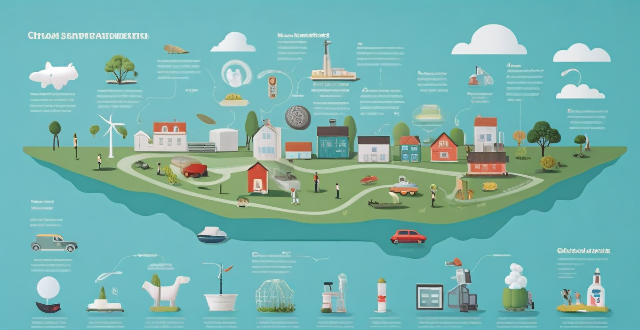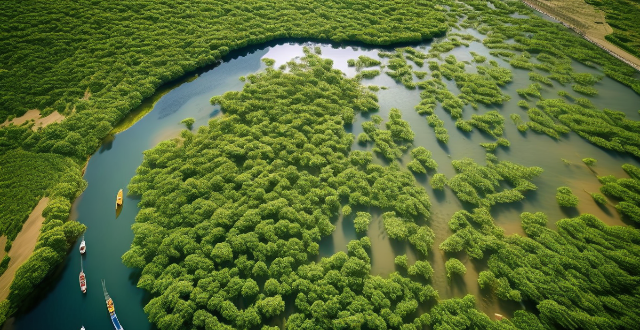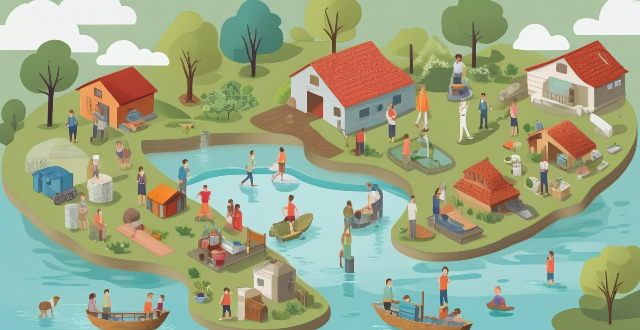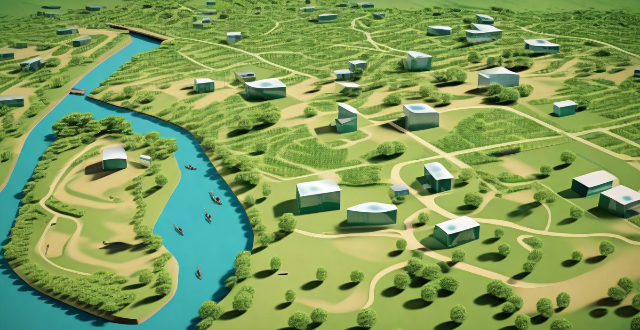Methods Ecosystem

How do ecosystem-based adaptation methods contribute to climate resilience ?
Ecosystem-based adaptation (EBA) methods play a crucial role in building climate resilience by leveraging the natural capacity of ecosystems to mitigate and adapt to the impacts of climate change. These approaches focus on conserving, restoring, and promoting sustainable management of ecosystems to provide essential services that help communities cope with climate-related stresses. Below are several ways EBA methods contribute to enhancing climate resilience: Protection from extreme events, enhancement of biodiversity, promotion of sustainable livelihoods, regulation of water resources, carbon sequestration and storage, community empowerment and education, disaster risk reduction, and research and innovation.

How can we measure the value of ecosystem services ?
The article discusses various methods to measure the value of ecosystem services, which are benefits humans derive from ecosystems. These include provisioning, regulating, cultural, and supporting services. Measuring their value is crucial for informed decisions about management and conservation. Methods include direct market valuation, indirect market valuation, revealed preference methods, avoided cost method, replacement cost method, and benefit transfer method. By using these techniques, policymakers and managers can make informed decisions about resource allocation for ecosystem conservation and restoration.

What are some strategies for conserving and managing ecosystem services ?
Ecosystem services are vital for human survival and well-being, providing food, water, flood control, cultural enrichment, and more. To conserve and manage these services effectively, strategies include protecting natural habitats, using resources sustainably, managing watersheds, adapting to climate change, promoting education and awareness, implementing supportive policies and legislation, and conducting ongoing research and monitoring. These efforts aim to safeguard ecosystems for future generations.

How do climate change and ecosystem services interact ?
Climate change and ecosystem services are interconnected phenomena that impact our planet. Climate change affects ecosystem services such as water regulation, food production, air purification, and recreational opportunities. Conversely, ecosystem services play a crucial role in mitigating climate change by promoting carbon sequestration, conserving biodiversity, and supporting sustainable land use practices. To address these challenges effectively, it is essential to consider both climate change and ecosystem services holistically and work towards integrated solutions that protect our planet's natural systems while meeting human needs sustainably.

How does biodiversity affect ecosystem services ?
Biodiversity plays a vital role in ecosystem services, including provisioning (like food and water), regulating (climate and flood control), cultural (recreational and spiritual enrichment), and supporting services (soil formation and nutrient cycling). Diverse plant species ensure resilience against pests and diseases, reducing the need for chemical interventions. Wetlands with varied vegetation types can more effectively filter pollutants from water than those with limited plant diversity. Different plant species play roles in carbon sequestration through photosynthesis, leading to more efficient carbon uptake and storage. Biodiversity can help regulate diseases by reducing the likelihood of pathogen spread. Diverse environments like coral reefs or tropical rainforests offer richer experiences for activities such as diving, hiking, and birdwatching. A variety of organisms, including bacteria, fungi, and earthworms, contribute to soil formation and maintenance, which is essential for plant growth. Different species have specialized roles in the cycling of nutrients. High biodiversity means functions can be performed by multiple species, providing a safety net if one species fails. Conservation efforts aimed at protecting and restoring biodiversity are vital for the sustained health of our planet's ecosystems.

What is the relationship between biodiversity and ecosystem services ?
The text discusses the relationship between biodiversity and ecosystem services, emphasizing that biodiversity is crucial for maintaining the health and functionality of ecosystems. It highlights that diverse species contribute to ecological processes, and many ecosystem services rely on specific species or groups. High biodiversity can lead to more resilient ecosystems, while its loss can diminish these services. The text suggests that conservation efforts can enhance both biodiversity and ecosystem services, underlining the importance of recognizing and protecting this relationship for human well-being.

How do climate targets relate to ecosystem conservation efforts ?
The text discusses the interconnection between climate targets and ecosystem conservation efforts, emphasizing that both are essential for a sustainable future. Climate targets focus on reducing greenhouse gas emissions and adapting to climate change impacts, while ecosystem conservation aims to protect biodiversity and maintain ecological processes. The two concepts are closely related, as climate change affects ecosystems, and ecosystems play a role in climate regulation. An integrated approach combining these efforts can lead to more effective outcomes, such as reforestation projects that sequester carbon and provide habitat for wildlife. Collaboration between various stakeholders is crucial for aligning climate targets with ecosystem conservation efforts.

What are ecosystem services and why are they important ?
Ecosystem services are benefits people obtain from ecosystems, including provisioning, regulating, cultural, and supporting services. These services play a crucial role in maintaining human health, well-being, and economic prosperity. Provisioning services provide food, water, timber, and medicinal resources necessary for human survival. Regulating services help control natural processes and mitigate disasters, protecting us from environmental hazards. Cultural services encompass non-material benefits like spiritual enrichment, recreation, and education. Supporting services enable the production of all other ecosystem services and are fundamental to the functioning of ecosystems. Preserving and enhancing these services through sustainable practices ensures a healthier planet and a brighter future for generations to come.

Can you provide examples of different types of ecosystem services ?
The text provides a detailed summary of the four main types of ecosystem services, namely supporting, regulating, provisioning, and cultural services. Supporting services form the foundation for all other services and include nutrient cycling, soil formation, and primary production. Regulating services control ecological processes such as climate regulation, disease regulation, and water purification. Provisioning services provide direct material benefits to humans, including food, freshwater, timber, and medicine. Cultural services encompass non-material benefits that contribute to human well-being, such as recreation, spiritual enrichment, and educational opportunities. The text emphasizes the importance of understanding these different types of ecosystem services to appreciate the value of nature and the significance of conservation efforts.

What is the role of ecosystem services in sustainable development goals ?
Ecosystem services, including provisioning, regulating, cultural, and supporting services, play a vital role in achieving sustainable development goals (SDGs) by providing essential resources for human well-being and economic development while maintaining the health and resilience of natural systems. Provisioning services like food security, clean water, energy, and medicinal resources are crucial for meeting SDGs 2, 6, and 7. Regulating services such as climate regulation, disease regulation, and flood and erosion control contribute to SDGs 13 and 15. Cultural services like recreation and tourism and cultural and spiritual values support SDG 8. Supporting services like soil formation and nutrient cycling and pollination are essential for agriculture and hence SDG 2. The interconnectedness of ecosystem services with other SDGs highlights their importance in building resilient societies that can withstand future challenges such as climate change, environmental degradation, and economic fluctuations. Preserving and enhancing these services is essential for achieving a sustainable future for all.

What are some innovative methods for teaching climate change in schools ?
Innovative Methods for Teaching Climate Change in Schools Climate change is a pressing issue that requires innovative approaches to teaching. Here are some methods that can help engage students and promote critical thinking: 1. Interdisciplinary Learning 2. Project-Based Learning (PBL) 3. Service Learning 4. Technology Integration 5. Inquiry-Based Learning 6. Field Trips and Experiential Learning

What methods can I use to simplify complicated equations ?
Simplify complex equations using techniques like factoring, combining like terms, applying the distributive property, elimination, substitution, graphical methods, completing the square, rationalization, using trigonometric identities, logarithmic properties, exponential rules, the Pythagorean identity, derivatives/integrals, matrix methods, and numerical approximation.

What are the most effective methods for improving industrial energy efficiency ?
The most effective methods for improving industrial energy efficiency include process optimization, using energy-efficient equipment, harnessing renewable energy sources, thermal management, power management, employee training and awareness, employing energy information systems, and complying with policy and regulatory standards. These methods can reduce operational costs, conserve resources, and minimize environmental impact.

How can I improve my memory using science-based methods ?
Improving memory can be achieved through various science-based strategies, including repetition, visualization, storytelling, mnemonic devices, chunking, maintaining a healthy lifestyle, practicing mindfulness and meditation, engaging in active learning, considering environmental context, and staying mentally active. These methods help move information from short-term to long-term memory, making it easier to recall later. Consistency and patience are crucial for enhancing cognitive functions.

How can augmented reality transform traditional teaching methods ?
Augmented Reality (AR) can revolutionize traditional teaching methods by providing an interactive and immersive learning experience. It can make learning more engaging, provide personalized feedback and guidance, facilitate group projects and remote collaboration, and provide contextual learning and virtual field trips. Incorporating AR into the classroom can create a more engaging and effective learning environment for students.

Can carbon sequestration help to restore degraded ecosystems ?
Carbon sequestration can play a significant role in restoring degraded ecosystems by enhancing biodiversity, improving soil health, mitigating climate change, and providing ecosystem services. It should be part of a broader strategy that includes sustainable land use practices, conservation efforts, and reduction of greenhouse gas emissions.

How can teachers effectively integrate multimedia resources into their innovative teaching methods ?
Integrating multimedia resources into teaching methods can greatly enhance the learning experience for students. Teachers should identify learning objectives, choose appropriate tools, create interactive lessons, encourage student participation, integrate technology in assessments, provide access to online resources, and continuously evaluate and update their methods. This approach ensures that teaching remains innovative and engaging for students.

How to manage payment methods for my Apple account ?
Apple offers multiple payment methods for users, including creditApple offers multiple payment methods for users, including credit Apple Pay, and gift cardsManaging your payment methods ensures a smooth experience when making purchases on Apple services like the App Store and iTunes Store.

What are the most effective methods for analyzing climate data ?
Analyzing climate data is a complex task that requires a deep understanding of the subject matter and the use of advanced statistical techniques. Some of the most effective methods for analyzing climate data include time series analysis, regression analysis, spatial analysis, principal component analysis (PCA), and machine learning algorithms. These methods help researchers to identify patterns, trends, and cycles in climate data, determine relationships between variables, analyze data with a geographical component, reduce the dimensionality of large datasets, and identify patterns and trends not apparent through traditional statistical techniques. By using these methods, researchers can gain insights into our changing planet and predict future climate conditions based on current trends.

Can you discuss the impact of personalized learning on innovative teaching methods ?
Personalized learning, an educational approach that tailors instruction to individual students' needs and preferences, has significantly influenced innovative teaching methods. This approach emphasizes a student-centered learning environment, flexible use of technology and space, and data-driven decision making. As a result, teaching methods have evolved to include differentiated instruction, mastery-based assessments, self-directed learning opportunities, and the integration of technology. These changes aim to create a more engaging, effective, and personalized educational experience for each student, fostering deeper understanding and higher retention rates.

Can you discuss the environmental impact of various energy storage methods ?
The text discusses the environmental impact of various energy storage methods, including batteries, pumped hydro storage, compressed air energy storage (CAES), and flywheels. It points out that while these methods allow for the efficient use of renewable energy sources and help to balance supply and demand, they also have varying levels of environmental impact. For example, battery production can result in water pollution and deforestation due to raw material extraction, while pumped hydro storage can affect local ecosystems and communities through land use and water usage. CAES may face challenges such as geological requirements and efficiency issues, and flywheels are considered an environmentally friendly option with a low environmental footprint. The text concludes that it is essential to consider both the efficiency and environmental implications of different energy storage solutions to ensure a sustainable future for our planet.

What are some innovative teaching methods that can enhance student engagement ?
Innovative teaching methods, including Project-BasedInnovative teaching methods, including Project-Basedroom, Gaming and Simulation Gaming and Simulations, Peer Teaching and Tutoring, Technology Integration, and Service Learning, are designed to enhance student engagement by fostering critical thinking, problem-solving, collaboration, and real-world application of knowledge. These approaches aim to make learning more interactive, relevant, and enjoyable for students, ultimately contributing to their academic success and personal growth.

How does a carbon tax compare to other methods of reducing carbon emissions ?
The article discusses the comparison of a carbon tax to other methods of reducing carbon emissions. It explains what a carbon tax is and lists other methods such as renewable energy sources, energy efficiency, carbon capture and storage, and forest management. The article then compares these methods in terms of cost-effectiveness, implementation speed, public acceptance, and environmental impact. It concludes that while a carbon tax is effective, it should be part of a broader strategy including investments in renewable energy, energy efficiency measures, CCS technology, and forest management for the best results in combating climate change.

Are there any specific training methods that celebrities use for muscle building and fat loss ?
Celebrities use a variety of training methods and nutrition plans to achieve their desired physique, including High-Intensity Interval Training (HIIT), weightlifting, cardiovascular exercise, Pilates and yoga, functional training, and strict nutrition plans. These methods are designed to burn fat, build muscle, improve flexibility and balance, and support overall fitness and mobility. However, individual results may vary depending on various factors.

Can sustainable fishing practices help mitigate the effects of climate change on the environment ?
Sustainable fishing practices are crucial for mitigating the effects of climate change on the environment. These practices aim to conserve marine ecosystems, reduce carbon emissions from fisheries, promote responsible consumption, maintain biodiversity, enhance carbon sequestration, and promote ecosystem-based management. By adopting sustainable fishing practices, we can help maintain the health and balance of our oceans in the face of climate change. As individuals and communities, we must support these practices and make responsible choices when consuming seafood products to protect our planet's delicate ecosystems and ensure a sustainable future for all.

How do urbanization and land use change affect ecosystem services ?
The text discusses the impact of urbanization and land use change on ecosystem services, including provisioning, regulating, cultural, and supporting services. It highlights how these changes can lead to decreased water supply, reduced food production, negative effects on climate regulation and flood control, loss of recreational opportunities and cultural values, and disruption of soil formation and nutrient cycling. Mitigation strategies such as green infrastructure, sustainable urban planning, and land stewardship are suggested to minimize these negative impacts and maintain essential ecological functions.

What are some effective methods for reviewing and retaining information before an exam ?
Preparing for an exam can be a daunting task, but with the right strategies and techniques, it is possible to effectively review and retain information before the exam. Some effective methods for reviewing and retaining information before an exam include creating a study plan, using active learning techniques, practicing retrieval and recall, and staying motivated and avoiding procrastination. By following these methods, students can improve their chances of success on their exams.

What are the effects of climate change on biodiversity and ecosystems ?
Climate change has significant effects on biodiversity and ecosystems, including habitat loss, changes in species distribution, altered ecosystem functioning, extinction risk, and impacts on human well-being.

How does environmental degradation affect global ecosystems ?
Environmental degradation affects global ecosystems in various ways, including loss of biodiversity, disruption of ecosystem services, changes in the carbon cycle, and impact on human health. It is crucial to take steps to mitigate environmental degradation and protect our planet's ecosystems for future generations.

How do extreme weather events influence biodiversity and ecosystems ?
Extreme weather events, such as flooding, drought, and heatwaves, significantly impact biodiversity and ecosystems. These events can cause habitat loss, species adaptation, and altered ecosystem structure and functioning. It is crucial to understand these impacts and take action to mitigate them through conservation efforts and climate change adaptation strategies. By doing so, we can help protect our planet's diverse flora and fauna and ensure the continued health of our ecosystems for future generations.